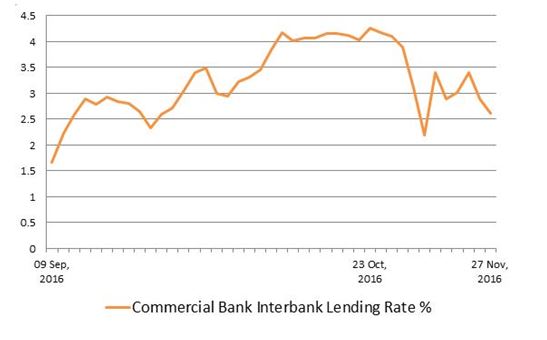Is the recent decline in interbank lending rate signaling rise in stock market?
Tue, Nov 29, 2016 4:31 PM on Latest, Featured, Stock Market,

Since the beginning of October, 2016, weighted average interbank lending rate among commercial banks had exceeded more than 4%. With the increase in liquidity crunch since mid- September, interbank lending rate was on an increasing trend. As per the statistics provided by Nepal Rastra Bank, the interbank lending rate among the commercial banks reached highest to 4.10% percent which has remained stagnant till the end of October.
However, the interest rate is decreasing in the recent days. The average weighted interbank lending rate has declined to 2.78% as on November 28. The rate has gone on a downward trend since the banks and financial system are generating further liquidity. What does this mean for stock market?
With the tight liquidity situation, most of the commercial banks are offering good interest rates to the general public on short term fixed deposits in order to gain more liquidity. The banks are mostly offering 7-8% annual interest on fixed deposits.
History has shown us that there is an inverse relationship between stock market growth and interest rate on deposits provided by the banks. Whenever there is a rise in this interest rate; market reacts negatively. Since the recent hike in interest rate is mainly due to the shortage of liquidity in the banking system, most of the avid investors are still observing the interest rates for confirming the trend in stock market.
Following factors can be considered which shows that there will be less liquidity crunch in the market in upcoming days:
 A big question arises with this: Is the recent decline in interbank lending permanent? If yes, it will definitely push down the market interest rate offered by commercial banks to the general public. In this situation, we can expect further rise in stock market but we need to look after other factors too.
A big question arises with this: Is the recent decline in interbank lending permanent? If yes, it will definitely push down the market interest rate offered by commercial banks to the general public. In this situation, we can expect further rise in stock market but we need to look after other factors too.
- Officials from Nepal Rastra Bank have informed that there is no liquidity problem as the central bank confirms the regular inflow and outflow of the cash.
- Of the total capital expenditure of Rs 311.95 billion, only 17.5 billion have been spend till Kartik end. This shows massive amount of cash is still in stock, which will gradually come in the banking channels.
- Inflow of remittance from migrant workers will increase with increase in dollar above Rs 110.
 A big question arises with this: Is the recent decline in interbank lending permanent? If yes, it will definitely push down the market interest rate offered by commercial banks to the general public. In this situation, we can expect further rise in stock market but we need to look after other factors too.
A big question arises with this: Is the recent decline in interbank lending permanent? If yes, it will definitely push down the market interest rate offered by commercial banks to the general public. In this situation, we can expect further rise in stock market but we need to look after other factors too.


